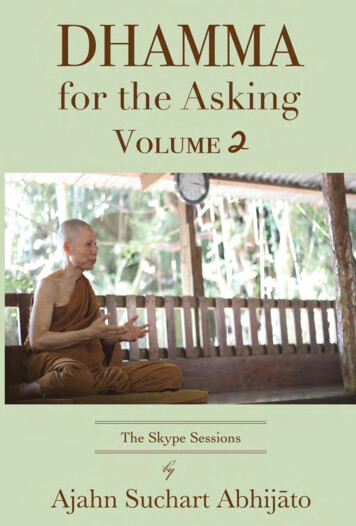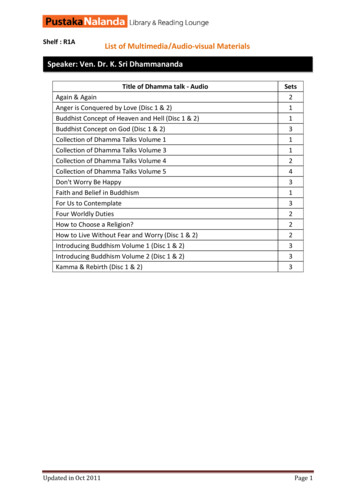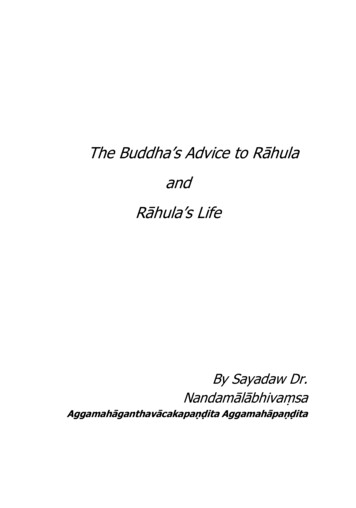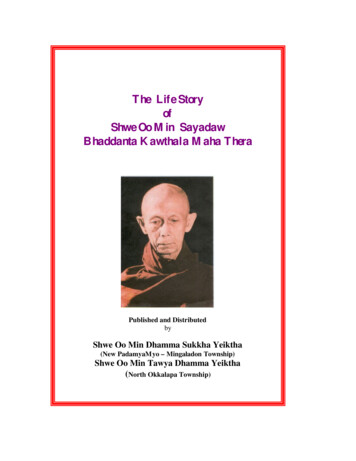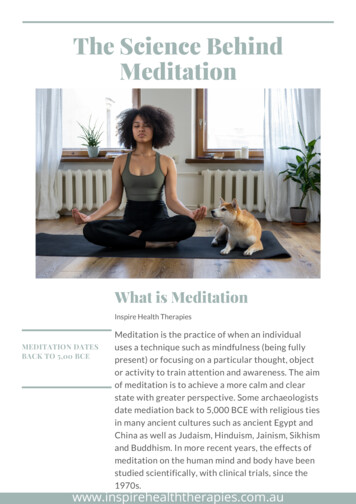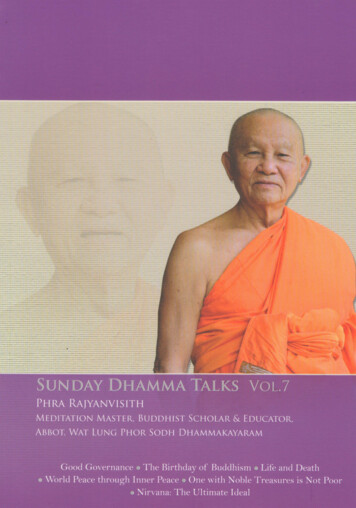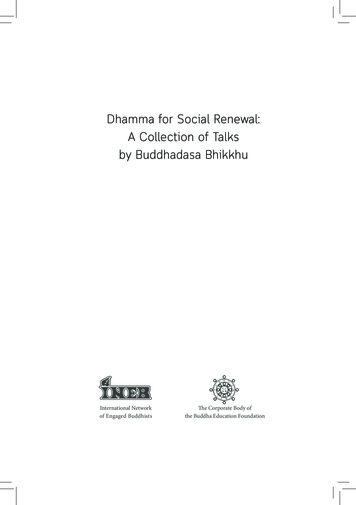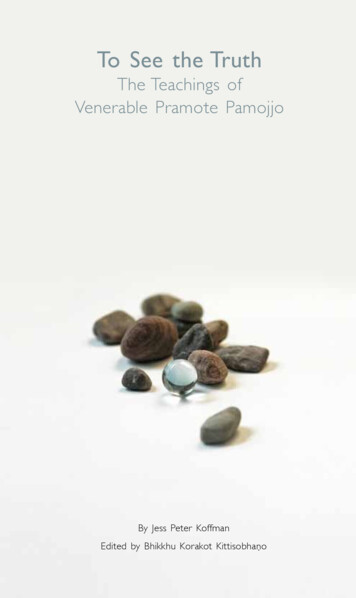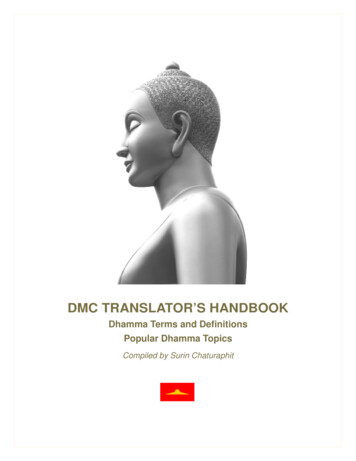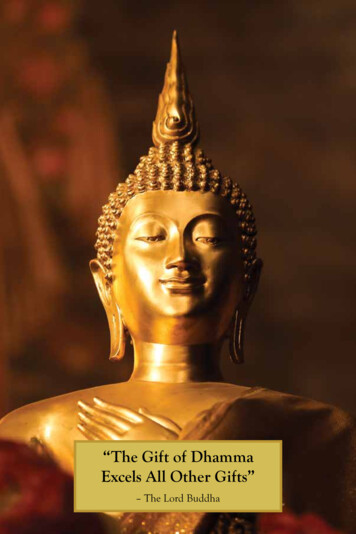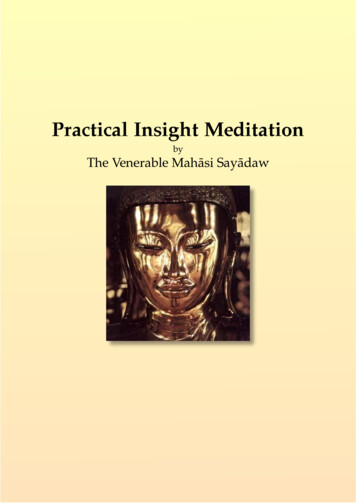
Transcription
Practical Insight MeditationbyThe Venerable Mahāsi Sayādaw
Practical Insight MeditationAuthor’s PrefaceIt is a uism to say that nobody likes suffering and everybody seekshappiness. In this world of ours, human beings are making all possible effortsfor prevention and alleviation of suffering, and enjoyment of happiness.Nevertheless, their efforts are mainly directed towards physical well-beingby material means. Happiness is, a er all, conditioned by a itudes of mind,and yet only a few persons give real thought to mental development, fewerstill practice mind aining in earnest.To illus ate this point, a ention may be drawn to the commonplace habitsof cleaning and tidying up one’s body, the endless pursuits of food, clothing,and shelter, and the emendous technological progress achieved for raisingthe material standard of living, for improving the means of ansport andcommunications, and for prevention and cure of diseases and ailments. Allthese efforts are, in the main, concerned with the care and nourishment ofthe body. It must be recognized that they are essential. However, these humanefforts and achievements cannot possibly bring about the alleviation oreradication of suffering associated with old age and disease, domesticinfelici and economic oubles, in short, with non-satisfaction of wants anddesires. Sufferings of this nature are not overcome by material means; theycan be overcome only by mind aining and mental development.Then, it becomes clear that the right way must be sought for aining,stabilizing and puri ing the mind. This way is found in the MahāsatipaṭṭhānaSu a, a well-known discourse of the Buddha, delivered well over 2,500 yearsago. The Buddha declared thus:“This is the sole way for the purification of beings, for theovercoming of sorrow and lamentation, for the des oying ofpain and grief, for reaching the right path, for the realisation ofnibbāna, namely the four foundations of mindfulness.”The four foundations of mindfulness are 1) the contemplation of the body,2) the contemplation of feelings, 3) the contemplation of mind, and 4) thecontemplation of mind objects.Obviously, this way should be followed by those in search of happiness,with a view to ge ing rid of the impurities of mind, which are the cause oftheir sufferings.i
iiPractical Insight MeditationIf one were asked whether he wished to overcome sorrow and lamentation,he would surely say, “Yes.” Then he, nay everybody, should practise the fourfoundations of mindfulness.If one were asked whether he wishes to des oy pain and grief, he wouldnot hesitate to reply in the affirmative. Then he, nay everybody, shouldpractise the four foundations of mindfulness.If one were asked whether he wishes to reach the right path and realisenibbāna, the state of being absolutely ee om old age, decay and death and om all sufferings, he would certainly give an affirmative answer. Then he,nay everybody, should practise the four foundations of mindfulness.How shall one practise the four foundations of mindfulness? In the MahāSatipaṭṭhāna Su a, the Buddha said, “Dwell practising body contemplation,feeling contemplation, mind contemplation and mind-objects contemplation.”Without the guidance of a well-qualified teacher, however, it will not be easyfor an average person to practise these contemplations in a systematic mannerin order to make progress towards development of concen ation and insight.Having myself undergone a most intensive practical course ofSatipaṭṭhāna meditation under the personal guidance of the Most VenerableMingun Jetavan Sayādaw of Thaton, I have imparted the technique ofmeditation ever since 1938 and given personal ins uction, as well as throughbooks and lectures, to several thousands of yogis. In compliance with therequests of those of the earlier batches, who had benefited om my personalins uctions, I wrote a eatise on vipassanā or insight meditation, in twovolumes. The eatise was completed in the year 1944 and has been publishedin seven editions. In all the chapters, except in Chapter V, dissertations anddiscussions are made with reference to Pāḷi texts, commentaries andsub-commentaries. In Chapter V, I chose to write in common language foreasy understanding by my pupils as to how they should begin and thenproceed step by step, stating fully the salient features, in line with theVisuddhimagga and some other texts.This present book is the English anslation of the said Chapter V. The firstfourteen pages of the Burmese original were anslated into English in 1954by U Pe Thin, an old pupil of mine, for the benefit of those who came omabroad to our Meditation Cen e. Pages 15 to 51 of the Burmese original were anslated into English, in compliance with the wish of the VenerableNyanaponika Mahāthera, by Myanaung U Tin, a disciple and supporter(dāyaka) of mine. Incidentally, it may be mentioned that the area of ourMeditation Cen e, Sāsana Yeikthā, is nearly twen -four acres, with over
Author’s Prefaceiiifi buildings to house the meditation teachers and yogis, monks as well aslay, both men and women.The Venerable Nyanaponika Mahāthera put this anslation into finalliterary shape a er obtaining confirmation of his valuable suggestions. U PeThin’s anslation was revised by and improved upon, as to s le, by MissMary McCollum, an American Buddhist lady. She practised Satipaṭṭhānameditation under the guidance of Anagārika Munindra at the Burmese Vihāra,Bodh-Gaya, Bihar, India. Anagārika Munindra stayed with us for a considerable period. He sent her revision to us for perusal and approval. Whendone, it was forwarded to the Venerable Nyanaponika Mahāthera. This bookis, therefore, the coordination and combined publications of the aforesaidtwo anslations, with my preface added thereto.Chapter V of my Burmese eatise, as mentioned earlier, was wri en incommon linguistic s le. I should like to say here that the doc inal termsfound in this book without Pāḷi names are fully explained in ‘Progress ofInsight,’ anslated om my Pāḷi eatise into English by the VenerableNyanaponika Mahāthera. His book, ‘The Heart of Buddhist Meditation,’ isitself a veritable mine of information and ins uction on this subject of vitalimportance.In conclusion, I would like to say that I deeply appreciate the services ofthose who have done the anslations and revisions as well as of those whoare responsible for the publication of this book, secondly to urge the readersof this book not to be content with the theoretical knowledge containedtherein but to apply that knowledge to systematic and sustained practice,and thirdly to express my earnest wish that they gain insight soon and enjoyall the benefits vouchsafed by the Buddha in the preamble of the MahāSatipaṭṭhāna Su a.Bhaddanta Sobhana (Aggamahāpaṇḍita)Mahāsi SayādawOctober 1st, 1970Sāsana Yeikthā,16, Hermitage Road,Rangoon, Burma
Venerable Mahāsi Sayādaw in 1948
Preparatory StageIf you sincerely desire to develop contemplation and a ain insight in thisyour present life, you must give up worldly thoughts and actions during the aining. This course of action is for the purification of conduct, the essentialpreliminary step towards the proper development of contemplation. Youmust also observe the rules of discipline prescribed for laymen, (or for monks,as the case may be) for they are important in gaining insight. For laypeople,these rules comprise the eight precepts which Buddhist devotees observe onsabbath days (uposatha) and during periods of meditation. An additionalrule is not to speak with contempt, in jest, or with malice to or about any ofthe noble ones who have a ained states of sancti . If you have done so,then personally apologize to him or her or make an apology through yourmeditation ins uctor. If in the past you have spoken contemptuously to anoble one who is at present unavailable or deceased, confess this offence toyour meditation ins uctor or in ospectively to yourself.The old masters of Buddhist adition suggest that you en ust yourselfto the Enlightened One, the Buddha, during the aining period, for you maybe alarmed if it happens that your own state of mind produces unwholesomeor ightening visions during contemplation. Also place yourself under theguidance of your meditation ins uctor, for then, he can talk to you anklyabout your work in contemplation and give you the guidance he thinksnecessary. These are the advantages of placing ust in the Enlightened One,the Buddha, and practising under the guidance of your ins uctor. The aimof this practice and its greatest benefit is release om greed, ha ed anddelusion, which are the roots of all evil and suffering. This intensive coursein insight aining can lead you to such release. So work ardently with thisend in view so that your aining will be successfully completed. This kind The eight Uposatha precepts are: abstention om 1) killing, 2) stealing, 3) all sexual activi ,4) lying, 5) intoxicants, 6) taking food a er noon, 7) dancing, singing, music, shows (a endance and performance), the use of perfumes, ornaments, etc., and 8) using luxurious beds. There are four noble individuals (ariya-puggala). They are those who have obtained a stateof sancti : a) The S eam-winner (sotāpanna) is one who has become ee om the first threeof the ten fe ers which bind him to the sensuous sphere, namely: personali belief, scepticaldoubt, and a achment to mere rites and rituals. b) The Once-returner (sakadāgāmi) hasweakened the fourth and fi h of the ten fe ers — sensuous craving and ill-will. c) TheNon-returner (anāgāmi) becomes fully ee om the above-mentioned five lower fe ers andis no longer reborn in the sensuous sphere before reaching nibbāna. d) Through the path ofHoliness (Arahant) one further becomes ee of the last five fe ers: craving for fine materialexistence (in celestial worlds), craving for immaterial (purely mental) existence, conceit,restlessness, and ignorance.1
2Practical Insight Meditationof aining in contemplation, based on the foundations of mindfulness(Satipaṭṭhāna), had been taken by successive Buddhas and noble ones whoa ained release. You are to be congratulated on having the opportuni totake the same kind of aining they had undergone.It is also important for you to begin your aining with a brief contemplation on the ‘four protections’ which the Enlightened One, the Buddha, offersyou for reflection. It is helpful for your psychological welfare at this stageto reflect on them. The subjects of the four protective reflections are theBuddha himself, loving-kindness, the loathsome aspects of the body, anddeath. First, devote yourself to the Buddha by sincerely appreciating his ninechief qualities in this way:Truly, the Buddha is holy, fully enlightened, perfect in knowledge andconduct, a welfarer, world-knower, the incomparable leader of men to betamed, teacher of gods and mankind, the awakened one and the exalted one.Secondly, reflect upon all sentient beings as the receivers of yourloving-kindness and identi yourself with all sentient beings withoutdistinction, thus: “May I be ee om enmi , disease and grief. As I am, soalso may my parents, preceptors, teachers, intimate and indifferent andinimical beings be ee om enmi , disease and grief. May they be released om suffering.”Thirdly, reflect upon the repulsive nature of the body to assist you indiminishing the unwholesome a achment that so many people have for thebody. Dwell on some of its impurities, such as stomach, intestines, phlegm,pus, blood. Ponder on these impurities so that the absurd fondness for thebody may be eliminated.The fourth protection for your psychological benefit is to reflect on thephenomenon of ever-approaching death. Buddhist teachings s ess that lifeis uncertain, but death is certain; life is precarious but death is sure. Life hasdeath as its goal. There is birth, disease, suffering, old age, and eventually,death. These are all aspects of the process of existence.To begin aining, take the si ing posture with the legs crossed. You mightfeel more comfortable if the legs are not inter-locked but evenly placed onthe ground, without pressing one against the other. If you find that si ingon the floor interferes with contemplation, then obtain a more comfortableway of si ing. Now proceed with each exercise in contemplation as described. The thir -two parts of the body as used in body contemplation are: head-hair, body-hair,nails, teeth, skin; nails, teeth, skin, flesh, sinews; bones, marrow; kidney, heart, liver, diaphragm, spleen; lungs, intestines, mesentery, stomach, excrement, bile, phlegm, pus, blood,sweat, lymph, tears, serum, saliva, nasal mucus, synovial fluid, urine, and brain.
Basic Exercise ITry to keep your mind (but not your eyes) on the abdomen. You willthereby come to know its rising and falling movements. If these movementsare not clear to you in the beginning, then place both hands on the abdomento feel these rising and falling movements. A er a short time the upwardmovement of exhalation will become clear. Then make a mental note of risingfor the upward movement, falling for the downward movement. Your mentalnote of each movement must be made while it occurs.From this exercise you learn the actual manner of the upward anddownward movements of the abdomen. You are not concerned with the formof the abdomen. What you actually perceive is the bodily sensation ofpressure caused by the heaving movement of the abdomen. So do not dwellon the form of the abdomen but proceed with the exercise. For the beginnerit is a very effective method of developing the faculties of a ention,concen ation of mind and insight in contemplation. As practice progresses,the manner of the movements will be clearer. The abili to know eachsuccessive occurrence of the mental and physical processes at each of the sixsense organs is acquired only when insight contemplation is fully developed.Since you are only a beginner whose a entiveness and power of concen ationare still weak, you may find it difficult to keep the mind on each successiverising movement and falling movement as it occurs. In view of this difficul ,you may be inclined to think, “I just don’t know how to keep my mind oneach of these movements.” Then simply remember that this is a learningprocess. The rising and falling movements of the abdomen are always presentand therefore there is no need to look for them. Actually it is easy for abeginner to keep his or her mind on these two simple movements.Continue with this exercise in full awareness of the abdomen’s rising andfalling movements. Never verbally repeat the words, ‘rising, falling,’ anddo not think of rising and falling as words. Be aware only of the actual processof the rising and falling movements of the abdomen. Avoid deep or rapidbreathing for the purpose of making the abdominal movements more distinct,because this procedure causes fatigue that interferes with the practice. Justbe totally aware of the movements of rising and falling as they occur in thecourse of normal breathing.Basic Exercise IIWhile occupied with the exercise of observing each of the abdominalmovements, other mental activities may occur between the noting of each3
4Practical Insight Meditationrising and falling. Thoughts or other mental functions, such as intentions,ideas, imaginings, are likely to occur between each mental note of risingand falling. They cannot be disregarded. A mental note must be made ofeach as it occurs.If you imagine something, you must know that you have done so andmake a mental note, imagining. If you simply think of something, mentallynote, thinking. If you reflect, reflecting. If you intend to do something,intending. When the mind wanders om the object of meditation which isthe rising and falling of the abdomen, mentally note, wandering. Shouldyou imagine you are going to a certain place, note going. When you arrive,arriving. When, in your thoughts, you meet a person, note meeting. Shouldyou speak to him or her, speaking. If you imaginarily argue with that person,note arguing. If you envision or imagine a light or colour, be sure to noteseeing. A mental vision must be noted on each occurrence of its appearanceuntil it passes away. A er its disappearance, continue with Basic Exercise I,by being fully aware of each movement of the rising and falling abdomen.Proceed carefully, without slackening. If you intend to swallow saliva whilethus engaged, make a mental note intending. While in the act of swallowing,swallowing. If you spit, spi ing. Then return to the exercise of noting risingand falling.Suppose you intend to bend the neck, note intending. In the act of bending,bending. When you intend to s aighten the neck, intending. In the act ofs aightening the neck, s aightening. The neck movements of bending ands aightening must be done slowly. A er mentally making a note of each ofthese actions, proceed in full awareness with noticing the movements of therising and falling abdomen.Basic Exercise IIISince you must continue contemplating for a long time while in oneposition, that of si ing or lying down, ( it is not advised that the meditatorshould use the lying posture except when it is time to sleep) you are likelyto experience an intense feeling of fatigue, stiffness in the body or in the armsand legs. Should this happen, simply keep the knowing mind on that partof the body where such feelings occur and carry on the contemplation, notingtired or stiff. Do this naturally; that is, neither too fast nor too slow. Thesefeelings gradually become fainter and finally cease altogether. Should oneof these feelings become more intense until the bodily fatigue or stiffness ofjoints is unbearable, then change your position. However, do not forget to
Basic Exercise III5make a mental note of intending, before you proceed to change your position.Each movement must be contemplated in its respective order and in detail.If you intend to li the hand or leg, make a mental note intending. In theact of li ing the hand or leg, li ing. S etching either the hand or the leg,s etching. When you bend it, bending. When pu ing it down, pu ing.Should either the hand or leg touch, touching. Perform all of these actionsin a slow and deliberate manner. As soon as you are se led in the newposition, continue with the contemplation in another position keeping to theprocedure outlined in this paragraph.Should an itching sensation be felt in any part of the body, keep the mindon that part and make a mental note, itching. Do this in a regulated manner,neither too fast nor too slow. When the itching sensation disappears in thecourse of full awareness, continue with the exercise of noticing the risingand falling of the abdomen. Should the itching continue and become toos ong and you intend to rub the itchy part, be sure to make a mental note,intending. Slowly li the hand, simultaneously noting the actions of li ing;and touching, when the hand touches the part that itches. Rub slowly incomplete awareness of rubbing. When the itching sensation has disappearedand you intend to discontinue rubbing, be mindful by making the usualmental note of intending. Slowly withdraw the hand, concurrently makinga mental note of the action, withdrawing. When the hand rests in its usualplace touching the leg, touching. Then again devote your time to observingthe abdominal movements.If there is pain or discomfort, keep the knowing mind on that part of thebody where the sensation arises. Make a mental note of the specific sensationas it occurs, such as painful, aching, pressing, piercing, tired, giddy. It mustbe s essed that the mental note must not be forced nor delayed but madein a calm and natural manner. The pain may eventually cease or increase.Do not be alarmed if it increases. Firmly continue the contemplation. If youdo so, you will find that the pain will almost always cease. But if, a er a time,the pain has increased and becomes unbearable, you must ignore the painand continue with the contemplation of rising and falling.As you progress in mindfulness you may experience sensations of intensepain: stifling or choking sensations, such as pain om the slash of a knife,the thrust of a sharp-pointed ins ument, unpleasant sensations of beingpricked by sharp needles, or of small insects crawling over the body. Youmight experience sensations of itching, biting, intense cold. As soon as youdiscontinue the contemplation you may also feel that these painful sensations
6Practical Insight Meditationcease. When you resume contemplation you will have them again as soonas you gain in mindfulness. These painful sensations are not to be consideredas something wrong. They are not manifestations of disease but are commonfactors always present in the body and are usually obscured when the mindis normally occupied with more conspicuous objects. When the mentalfaculties become keener you are more aware of these sensations. With thecontinued development of contemplation the time will come when you canovercome them and they will cease altogether. If you continue contemplation,firm in purpose, you will not come to any harm. Should you lose courage,become irresolute in contemplation and discontinue for some time, you mayencounter these unpleasant sensations again and again as your contemplationproceeds. If you continue with determination you will most likely overcomethese painful sensations and may never again experience them in the courseof contemplation.Should you intend to sway the body, then knowingly note intending.While in the act of swaying, swaying. When contemplating you mayoccasionally discover the body swaying back and forth. Do not be alarmed;neither be pleased nor wish to continue to sway. The swaying will cease ifyou keep the knowing mind on the action of swaying and continue to noteswaying until the action ceases. If swaying increases in spite of your makinga mental note of it, then lean against a wall or post or lie down for a while.Therea er proceed with contemplation. Follow the same procedure if youfind yourself shaking or embling. When contemplation is developed youmay sometimes feel a thrill or chill pass through the back or the entire body.This is a symptom of the feeling of intense interest, enthusiasm or rapture.It occurs naturally in the course of good contemplation. When your mind isfixed in contemplation you may be startled at the slightest sound. This takesplace because you feel the effect of sensory impression more intensely whilein a state of concen ation.If you are thirs while contemplating, notice the feeling, thirs . Whenyou intend to stand, intending. Keep the mind intently on the act of standingup, and mentally note standing. When you look forward a er standing ups aight, note looking, seeing. Should you intend to walk forward, intending.When you begin to step forward, mentally note each step as walking,walking, or le , right. It is important for you to be aware of every momentin each step om the beginning to the end when you walk. Adhere to thesame procedure when s olling or when taking walking exercise. Try to makea mental note of each step in two sections as follows: li ing, pu ing, li ing,
Basic Exercise III7pu ing. When you have obtained sufficient practice in this manner ofwalking, then y to make a mental note of each step in three sections; li ing,pushing, pu ing; or up, forward, down.When you look at the tap or water-pot on arriving at the place where youare to take a drink, be sure to make a mental note, looking, seeing. When you stop walking, stopping. When you s etch out the hand, s etching. When you touch the cup, touching. When you take the cup, taking. When dipping the cup into the water, dipping. When bringing the cup to the lips, bringing. When the cup touches the lips, touching. When you swallow, swallowing. When returning the cup, returning. When withdrawing the hand, withdrawing. When you bring down the hand, bringing. When the hand touches the side of the body, touching. If you intend to turn round, intending. When you turn round, turning. When you walk forward, walking. On arriving at the place where you intend to stop, intending. When you stop, stopping.If you remain standing for some time continue the contemplation of risingand falling. But if you intend to sit down, note intending. When you go tosit down, walking. On arriving at the place where you will sit, arriving.When you turn to sit, turning. While in the act of si ing down, si ing. Sitdown slowly, and keep the mind on the downward movement of the body.You must notice every movement in bringing the hands and legs into position.Then resume the practice of contemplating the abdominal movements.Should you intend to lie down, note intending. Then proceed with thecontemplation of every movement in the course of lying down: li ing,s etching, pu ing, touching, lying. Then take as the object of contemplationevery movement in bringing the hands, legs and body into position. Performthese actions slowly. Therea er, continue with noting rising and falling.Should pain, fatigue, itching, or any other sensation be felt, be sure to noticeeach of these sensations. Notice all feelings, thoughts, ideas, considerations,reflections; all movements of hands, legs, arms, and body. If there is nothingin particular to note, put the mind on the rising and falling of the abdomen.
8Practical Insight MeditationWhen sleepy, make a mental note, sleepy. A er you have gained sufficientconcen ation in contemplating you will be able to overcome drowsinessand you will feel re eshed as a result. Take up again the usual contemplationof the basic object. If you are unable to overcome the drowsy feeling, youmust continue contemplating drowsiness until you fall asleep.The state of sleep is the continui of sub-consciousness. It is similar tothe first state of rebirth consciousness and the last state of consciousness atthe moment of death. This state of consciousness is feeble and therefore,unable to be aware of an object. When you awake, the continui ofsub-consciousness occurs regularly between moments of seeing, hearing,tasting, smelling, touching, and thinking. Because these occurrences are ofbrief duration they are not usually clear and therefore not noticeable.Continui of sub consciousness remains during sleep — a fact which becomesobvious when you wake up; for it is in the state of wakefulness that thoughtsand sense objects become distinct.Contemplation should start at the moment you wake up. Since you area beginner, it may not be possible yet for you to start contemplating at thevery first moment of wakefulness. But you should start with it when youremember that you are to contemplate. For example, if on awakening youreflect on something, you should become aware of the fact and begin yourcontemplation by a mental note, reflecting. Then proceed with the contemplation of rising and falling. When ge ing up om the bed, mindfulnessshould be directed to every detail of the body’s activi . Each movement ofthe hands, legs and rump must be performed in complete awareness. Areyou thinking of the time of day when awakening? If so, note thinking. Doyou intend to get out of bed? If so, note intending. If you prepare to movethe body into position for rising, note preparing. As you slowly rise, rising.Should you remain si ing for any length of time, revert to contemplatingthe abdominal movements.Perform the acts of washing the face or taking a bath in due order and incomplete awareness of every detailed movement; for instance, looking,seeing, s etching, holding, touching, feeling cold, rubbing. In the acts ofdressing, making the bed, opening and closing doors and windows, handlingobjects, be occupied with every detail of these actions in sequence.You must a end to the contemplation of every detail in the action of eating: When you look at the food, looking, seeing. When you arrange the food, arranging. When you bring the food to the mouth, bringing.
Advancement in Contemplation9 When you bend the neck forwards, bending.When the food touches the mouth, touching.When placing the food in the mouth, placing.When the mouth closes, closing.When withdrawing the hand, withdrawing.Should the hand touch the plate, touching.When s aightening the neck, s aightening.When in the act of chewing, chewing.When you are aware of the taste, knowing.When swallowing the food, swallowing.While swallowing the food, should the food be felt touching the sidesof the gullet, touching.Perform contemplation in this manner each time you take a morsel offood until you finish your meal. In the beginning of the practice there willbe many omissions. Never mind. Do not waver in your effort. You will makefewer omissions if you persist in your practice. When you reach an advancedstage of the practice you will also to be able to notice more details than thosementioned here.Advancement in ContemplationA er having practised for a day and a night you may find yourcontemplation considerably improved. You may be able to prolong the basicexercise of noticing the abdominal movements. At this time you will noticethat there is generally a break between the movements of rising and falling.If you are in the si ing posture, fill in this gap with a mental note of the factof si ing in this way: rising, falling, si ing. When you make a mental noteof si ing, keep your mind on the erect position of the upper body. Whenyou are lying down you should proceed with full awareness as follows:rising, falling, lying. If you find this easy, continue with noticing these threesections. Should you notice that a pause occurs at the end of the rising aswell as at the end of the falling movement, then continue in this manner:rising, si ing, falling, si ing. Or when lying down: rising, lying, falling,lying. Suppose you no longer find it easy to make a mental note of three orfour objects in the above manner. Then revert to the initial procedure ofnoting only the two sections; rising and falling.While engaged in the regular practise of conte
meditation ever since 1938 and given personal ins uction, as well as through books and lectures, to several thousands of yogis. In compliance with the requests of those of the earlier batches, who had benefited om my personal ins uctions, I wrote a eatise on vipassanā or insight meditation, in two volumes.
